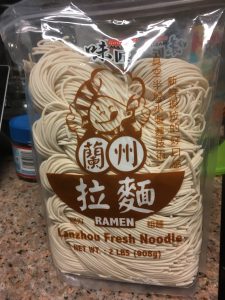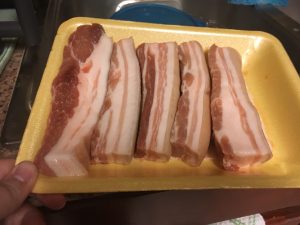David Chang’s Shoyu Ramen
By Sarah Clarke • December 14, 2018
An Introduction
What do you think of when you think of ramen? An instant cup of noodles with freeze-dried carrots and corn? A packet of bland white noodles with some sort of spice soup base and hot water? Maybe what you suppose is an ‘authentic’ bowl of ramen from the Chinese store downtown?
What ramen means to you or I, depending on where you are in the world, can greatly vary. I know that I grew up with the Maruchan Ramen packets that would sell for a dollar for a packet of six of the things. I have learned that this world of ramen noodles spreads way beyond aisle 18 of your local grocery.
The Process Fails
For my recipe, I learned how to make Tokyo (Shoyu) ramen, but I had to modify it after had a minor mishap making the broth. I followed making the dish true in terms of the noodles and toppings, but you need to have a strong stomach to make your broth at home.
The specific recipe I based my ramen of off can be found here. I followed the basics of this recipe, but the first go around I wanted to have a chicken and pork broth, so instead of prepping just the pork, I also added in some chicken feet. (I also found pork leg instead of pork shoulder, but what else is a girl on a budget supposed to do?)

Now, here, here… This is the part that got me. In my infinite wisdom (read: sarcastic) and following my boyfriend’s roommate’s suggestion, I decided to boil said chicken feet to make the broth, while simultaneously cooking the bloody pork leg bone. What immersed out of the kitchen due to this epic combination of burning flesh is what can only be described as lighting a carcass on fire because well, that’s what we were doing for the name of cooking. According to my boyfriend’s roommate, I needed to cut off the claws from the chicken feet while simultaneously trying not to gag from the dead body smell ensnaring my nostrils.
Now, let me tell you dear reader, that was almost as bad as the boiling skin afterword. But yes, I cut off those nails. It was awful. If you have ever cut your dog’s nails, you know how you have to take the clippers and you know, get in there and get it off. I didn’t have clippers. I had to take a chef’s knife, hold hands with a disembodied chicken foot, turn it fifteen different ways, and try to cut the damn thing’s entire claw off. Cutting the tip of their toe off. And if I was too unfortunate not to hit the exact junction between the claw and the bone, I would have to saw through one or the other.
So let me repeat, dear reader: MAKING MEAT BROTH FROM SCRATCH IS NOT FOR THE FAINT OF HEART. OR FOR ANYONE CONSIDERING VEGETARIANISM. THIS PROCESS WILL TIP YOU OVER THE EDGE.
And after cutting their nails, smelling burning skin, and looking at the congealed blood on the pork leg, I promptly decided that I would not be making homemade broth anymore. I had my boyfriend and his roommate march the bones to the dumpster, and we aired out the apartment with Lysol, Febreze, and an air purifier for well over a day.
Thus, I decided: I am using beef bouillon cubes I found at the local Asian grocery instead and if anyone was going to mess with me about it, they can go hold hands with a dead, twitching, curling chicken hand.
The Specifics
It all begins in the same place, whether your noodles are sold in those little Styrofoam cups or made fresh at home: ramen noodles. You can buy these at a typical grocer if you like the little nervous block they give you in the Maruchan or Top Ramen packets but select grocers and certainly Asian markets sell ramen noodles like you find spaghetti noodles, straight and in a box.

For my ramen, I used Lanzhou Noodles that I found in my local Asian grocery. These noodles are different than the ones that you find packaged in the Maruchan as they are more hydrated and alive than typical straight noodles you buy in a box. These noodles come in little bundles in the bag, so you don’t need to put all four or five bundles in the pot (like I accidentally did) unless you are truly planning to feed at least 6 people.
To start this recipe without using a homemade broth, I used beef bouillon cubes. I did not have any type of pork bouillon cubes, so I stayed somewhat in the same flavor family and used a beef broth base. Pictured here are the cubes dissolving in the boiling water. You want to add in a cube for each serving of noodles that you use, ultimately I ended up using 6.
Your broth should ultimately end up looking like the following on the right.


After starting the boil for the broth, I pulled out my defrosted pork belly. I defrosted this in the fridge a day prior to making the ramen. You need to pan-fry the meat before it goes into your ramen. I fried this meat with seasame oil to match the meat with the flavors of the soy sauce and dumpling sauce I was adding to the ramen.
A word to the wise: Cut off the pork skin if you are using pork belly. I did not, and it ultimately did not fry the fat of the pork as it should have.
 After a bit of frying, your pork belly should begin showing signs of being edible, shown to the left.
After a bit of frying, your pork belly should begin showing signs of being edible, shown to the left.
While working with the pork, I began the process of juggling pots and pans through adding the noodles to the pot. As I mentioned earlier, I accidentally added the whole bag of noodles to the pot. If you use Lanzhou noodles, do yourself a favor and only use 2 or 3 bundles.
After a bit of boiling and expansion, your noodles should look plump and delicious, shown to the right.
Now you are getting close to the end of the process. Traditional shoyu ramen often has a hard boiled egg cut in half and served with it, but my boyfriend and I prefer
scrambled eggs. If you feel the same, learn from my mistakes. Do not crack your egg over the noodles, like I foolishly did. Fry the egg in a little pan and proceed to break it up and put it on top of the noodles.

If you decide to ignore this warning and crack the egg over the noodles because you are just enough of a rebel to not listen to the girl that already did this wrong: good for you. But this is going to be your result. I hope you like noodle mush.
Here, like my mistakes in the broth, is where I started to doubt myself. I don’t know, but something about apparent noodle mush didn’t excite me. It was better than expected, at least.
DON’T FORGET ABOUT THE MEAT!

I mean, it’s probably on the stove right there next to the noodles, but I have made the mistake. So here, seen in the picture on the right, the meat has fried more, but if you look on the non-fried edges, you will see the brownish-yellow skin. I hope you cut that off earlier. If not, cut it off now while it’s still redeemable.
While you are waiting on the final pieces of the meat, you can go ahead and prepare whatever toppings you desire. I wanted bamboo shoots, carrots, and green onions. You can buy a bag of preserved bamboo shoots at the store, so go ahead and fry them up in that meat pan (shown cooked below). Cut up those carrots and thinly chunk your green onions. You got this; I believe in you.




And now for the finale, you have all your pieces together. Put your eggy ramen noodles in a bowl, chop up that pork belly, grab those tongs and give yourself a helping of those bamboo shoots, hell carrots and green onions too.
You’ve earned this. And if you actually followed my tips and advice in bold to do specifically not what I did wrong, you will have both a photogenic and delicious meal. (For me though, I failed at cooking ramen for the third time, and we went to Waffle House).
